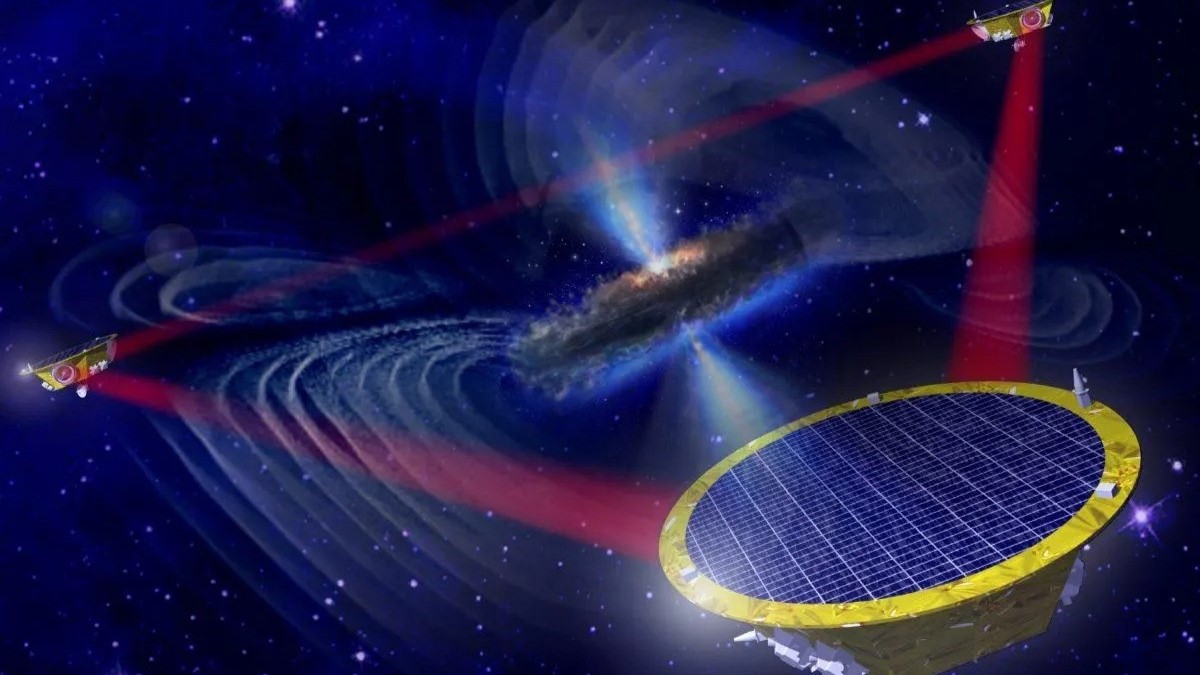Europe approves LISA, a next-generation space mission that will discover the faintest ripples in space-time
The new LISA gravitational wave detector, which will be launched into orbit in 2035, promises to detect cosmic collisions from the earliest moments after the Big Bang.

The European Space Agency and NASA have greenlit their Laser Interferometer Space Antenna (LISA) project — a gigantic space-based gravitational wave detector set to detect the ripples in space-time caused when the huge black holes at the centers of galaxies collide with other massive objects.
The detector will consist of three spacecraft floating 1.6 million miles (2.5 million kilometers) apart, forming a triangle of laser light that can detect distortions in space caused by the universe-rattling impacts of neutron stars and black holes.
The interferometer follows the same principles as the existing, ground-based LIGO (Laser Interferometer Gravitational-Wave Observatory) experiment that first detected gravitational waves in 2015. But LISA's million-fold increase in scale will enable it to detect lower-frequency gravitational waves, revealing cosmic crashes currently inaccessible to LIGO.
Related: 'Tsunami' of gravitational waves sets record for most ever space-time ripples detected
"Using laser beams over distances of several kilometers, ground-based instrumentation can detect gravitational waves coming from events involving star-sized objects — such as supernova explosions or merging of hyper-dense stars and stellar-mass black holes. To expand the frontier of gravitational studies we must go to space," Nora Lützgendorf, LISA lead project scientist, said in a statement. "Thanks to the huge distance traveled by the laser signals on LISA, and the superb stability of its instrumentation, we will probe gravitational waves of lower frequencies than is possible on Earth, uncovering events of a different scale, all the way back to the dawn of time."
Gravitational waves are the shock waves created in space-time when two extremely dense objects — such as neutron stars or black holes — collide.
The LIGO detector spots gravitational waves by picking up the tiny distortions in the fabric of space-time that these waves make as they pass through Earth. The L-shaped detector has two arms with two identical laser beams inside, each 2.48-miles (4 kilometers) long.
Get the world’s most fascinating discoveries delivered straight to your inbox.
When a gravitational wave laps at our cosmic shores, the laser in one arm of the LIGO detector is compressed and the other expands, alerting scientists to the wave's presence. But the tiny scale of this warping (often the size of a few thousandths of a proton or neutron) means that detectors have to be incredibly sensitive — and the longer these detectors are, the more sensitive they become.
LISA's constellation of three spacecraft, whose construction will begin in 2025, will house three Rubik's-cube-sized gold-platinum cubes firing laser beams into each others' telescopes millions of miles away.
As the satellites follow Earth in its orbit around the sun, any miniscule disruptions to the path lengths between them will be registered by LISA and sent back to scientists. Then, researchers will be able to use the precise changes to each beam to triangulate where the gravitational disturbances come from, pointing optical telescopes at them for further investigation.
And because gravitational ripples are generated even before super-heavy astronomical objects touch, LISA will give scientists months of advanced warning before a collision is visible to optical telescopes.
The detector's unprecedented sensitivity will also open a window to some of the faintest ripples originating from events in the epoch of cosmic dawn — the gory aftermath of the Big Bang — and probe some of cosmology's biggest and most pressing questions.
The telescope, made as part of a collaboration between ESA, NASA and international scientists, will be lifted to the heavens on board an Ariane 3 rocket in 2035.

Ben Turner is a U.K. based writer and editor at Live Science. He covers physics and astronomy, tech and climate change. He graduated from University College London with a degree in particle physics before training as a journalist. When he's not writing, Ben enjoys reading literature, playing the guitar and embarrassing himself with chess.


